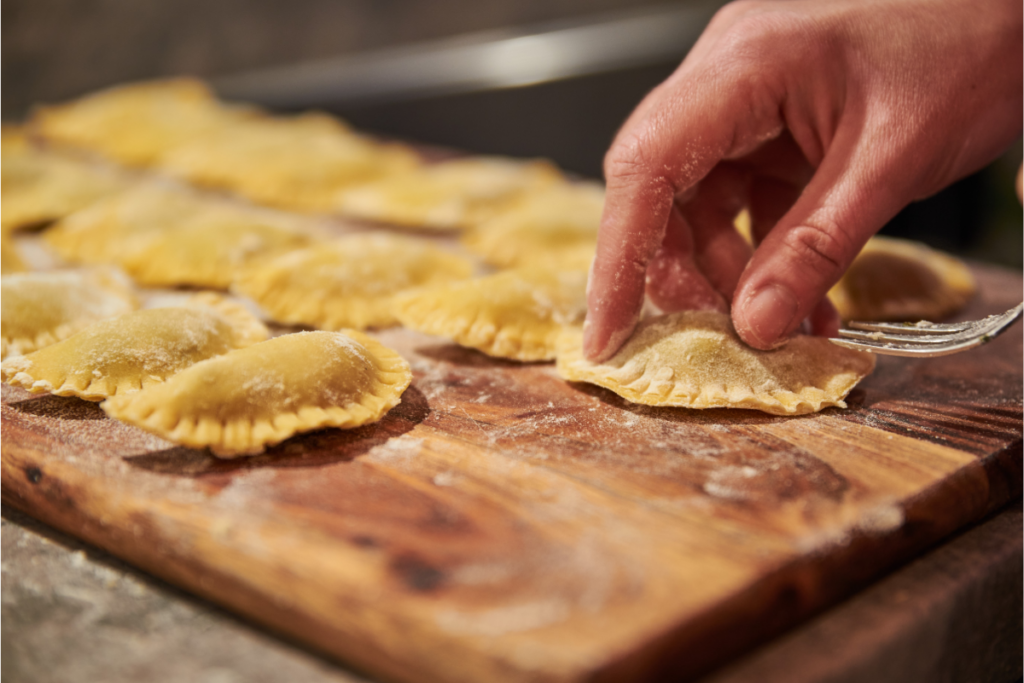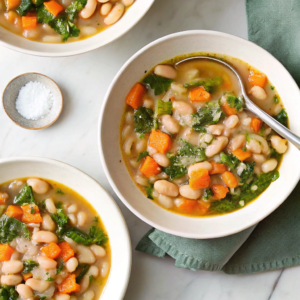Ravioli is a beloved pasta dish known for its versatility, encompassing a variety of fillings and sauces. To elevate the taste of your ravioli, it’s important to consider both the inside and outside components of the dish. The right additions can transform it from a simple meal to a gourmet experience. Whether you’re preparing homemade ravioli or enhancing store-bought ones, a few key ingredients and techniques can make a significant difference in flavor.
Enhancing the filling is the first step to more flavorful ravioli. Fresh herbs, spices, and quality cheeses can infuse the filling with rich, aromatic flavors that meld beautifully with the pasta. For instance, adding a blend of Italian herbs to a ricotta cheese filling imparts a classic flavor, while spices like nutmeg or pepper add depth. Additionally, incorporating ingredients like sautéed vegetables, cooked meats, or even a touch of citrus zest can introduce new flavors to your palate.
Fundamentals of Ravioli Making
Ravioli, one of the classic Italian pastas, encapsulates the essence of good cuisine through its filling, pasta dough, and sauce pairing. Mastering the fundamentals of ravioli making enhances its flavor and ensures a delicious outcome.
Choosing the Right Filling
Your filling choice is pivotal. For a savory option, consider a mushroom blend which would be particularly delightful and can be further explored with a mushroom ravioli recipe. Alternatively, opt for cheeses like ricotta or meat such as ground beef. Season your filling well, ensuring it is neither too dry nor overly moist to prevent rupturing the dough when cooking.
Perfecting the Pasta Dough
Aim for a thin yet durable pasta dough that’s strong enough to hold the filling. Roll it to about 1/16 inch thick. The dough should be pliable but not sticky and rested before filling.
Assembling with Care
When assembling ravioli, distribute the filling evenly, leaving space on the edges to seal them properly. A common technique is to lay one sheet of dough flat, add the filling in small mounds, and cover it with another dough sheet. Press around the mounds to expel air and seal with either your fingers or a ravioli stamp.
Cooking to Perfection
Boil ravioli in salted water until they float to the top and are al dente. The cooking period will be brief, usually between 4 to 7 minutes, based on size.
Sauce Pairing
A sauce that complements the filling will elevate your ravioli. Light butter or cream sauces work well with cheese or vegetable fillings, while heartier tomato or meat sauces pair nicely with robust meat fillings. For a specific pairing, learn what pairs with mushroom ravioli.
With these basics in mind, you are well on your way to crafting exquisite ravioli that are sure to tantalize your taste buds.
Choosing the Right Fillings
The key to enhancing your ravioli is to select fillings that complement each other and appeal to your palate. Consider the balance of flavors and textures when choosing your fillings.
Cheese Varieties
- Ricotta: A classic choice, creamy and mild, perfect for blending with other ingredients.
- Mozzarella: Offers a pleasant melt and subtle taste, ideal for baked ravioli dishes.
- Parmesan: Grate it fresh for a salty, nutty flavor boost.
- Gorgonzola: For a bold option, this blue cheese delivers a strong, tangy kick.
Pro tip: Make sure all of these are rennet-free to get the maximum flavor experience from them.
Meats and Seafood
- Beef: Ground beef or short ribs provide a hearty and rich filling.
- Chicken: Opt for roasted and shredded chicken for a lighter touch.
- Lobster: Chunks of lobster can add a luxurious twist to your ravioli.
- Shrimp: A popular choice for seafood lovers, imparting a delicate, sweet flavor.
Vegetables and Herbs
- Spinach: Sautéed with garlic, adds color and a subtle earthy flavor.
- Mushrooms: Cooked down, they offer a meaty texture and umami taste.
- Basil: Fresh leaves provide a fragrant, peppery note.
- Sage: Crisp it in brown butter for a distinctive aromatic topping.
Nuts and Seeds
- Pine Nuts: Toast lightly for a slight crunch and buttery taste.
- Walnuts: Crush into smaller pieces for a rich, earthy addition.
- Pumpkin Seeds: Pepitas bring a nice texture contrast and a mild, nutty flavor.
Sauces to Complement Ravioli
Selecting the right sauce is vital for enhancing the flavors of ravioli. A harmonious sauce pairing can elevate your dish from good to exceptional.
Classic Tomato
A classic tomato sauce is a versatile choice that goes well with a wide variety of ravioli fillings. A simple marinara made with ripe tomatoes, garlic, onions, and a touch of basil can bring out the freshness of the pasta. Be sure to simmer the sauce to develop depth of flavor and allow the natural sweetness of the tomatoes to shine.
Rich Cream-Based
For a decadent, indulgent experience, a rich cream-based sauce like Alfredo or a white wine cream sauce can be exquisite. These sauces benefit from additions like Parmesan or Pecorino cheese and a pinch of nutmeg to enhance their creamy texture. Such sauces pair excellently with cheese or meat-filled ravioli, providing a luxurious mouthfeel.
Herb-Infused Oil
Simple yet flavorful, herb-infused oil sauces provide a light dressing to ravioli, allowing the pasta’s filling to be the star. Use high-quality olive oil infused with herbs like rosemary, thyme, or basil. Drizzling this over ravioli can add a subtle hint of flavor without overpowering the delicate taste of fillings such as Baby Bella mushrooms.
Nutty Brown Butter
The simplicity of nutty brown butter sauce is its strength. It offers a warm, toasty flavor that complements earthy ravioli fillings, such as those made with spinach or mushrooms. When browning the butter, watch for a golden-brown color and a nutty aroma to ensure it’s perfectly cooked. A sprinkle of sage leaves fried in the butter adds an extra layer of flavor.
Cooking Techniques
Perfecting your cooking techniques can significantly enhance the taste and texture of your ravioli. Paying close attention to boiling, sautéing, and baking can elevate your pasta dish from good to outstanding.
Boiling Practices
Boil ravioli in plenty of salted water to ensure they cook evenly and acquire a subtle seasoning. For al dente pasta, follow the recommended cooking time on the package, usually between 4 to 6 minutes.
Sautéing Ravioli
After boiling, sautéing ravioli in a pan with a bit of oil or butter can add a pleasing crispy texture and golden color. Incorporating aromatics like garlic or shallots and herbs such as basil or rosemary can impart additional flavors to the ravioli.
Baking Options
Baking ravioli is an excellent method for creating a different texture. Arrange the cooked ravioli in a single layer in a baking dish, cover with sauce and cheese, and bake until bubbly and golden on top. A variation of this technique includes the Easy Enoki Mushroom Recipe as a topping for a crunchy, umami-packed finish.
Toppings and Garnishes
Enhancing the flavor of ravioli can be as simple as adding the right toppings or garnishes. Each choice can transform the taste and texture, creating a more enjoyable dining experience.
Cheese Toppings
Parmesan: A classic choice, freshly grated Parmesan cheese lends a salty, umami kick to ravioli.
Ricotta Salata: For a milder option, try crumbled Ricotta Salata which adds creaminess without overpowering.
Herb Enhancements
Basil: Brighten your dish with fresh basil leaves, which impart a sweet, peppery flavor.
Chives: Snipped chives offer a mild onion-like essence, perfect for balancing richer fillings.
Crunchy Breadcrumbs
Crunchy breadcrumbs bring a satisfying textural contrast. Toss them in olive oil and toast until golden before sprinkling over your ravioli.
Edible Flowers
For an elegant touch, consider garnishing with edible flowers. They add a subtle, aromatic taste and make for a visually stunning presentation.
Pairing with Sides
Choosing the right side dishes can enhance your ravioli meal. The sides should complement the flavors without overpowering the delicate taste of ravioli.
Simple Salads
A simple salad with a light vinaigrette can cut through the richness of the ravioli. Consider these options for your salad:
- Mixed greens with cherry tomatoes and shaved Feta
- Arugula with lemon dressing and pine nuts
Roasted Vegetables
Roasted vegetables add a satisfying texture and an earthy flavor that pairs well with pasta. Try these combinations:
- Asparagus and cherry tomatoes, seasoned with garlic and olive oil
- Medley of zucchini, squash, and bell peppers with Italian herbs
Garlic Bread Classics
Garlic bread offers a classic and comforting side that is perfect for soaking up any additional sauce. Consider these varieties:
- Traditional garlic baguette
- Ciabatta with garlic butter and a sprinkle of herbs
Flavor Profiles
Crafting a well-rounded flavor profile for your ravioli involves understanding how to balance tastes and apply seasonings effectively.
Balancing the Five Tastes
Each taste—sweet, sour, salty, bitter, and umami—plays a pivotal role in creating a harmonious flavor. Here’s how you can balance these tastes within ravioli fillings and sauces:
- Sweet: Counterbalance salty or bitter elements with ingredients like caramelized onions or a touch of sugar in the sauce.
- Sour: Brighten up heavy or rich fillings with a squeeze of lemon juice or a dash of vinegar.
- Salty: Enhance the overall flavor with a sprinkle of sea salt or by incorporating aged cheeses.
- Bitter: Add complexity with slightly bitter greens like arugula or by using a dark roux in the sauce.
- Umami: Deepen the savoriness with mushrooms, sun-dried tomatoes, or grated Parmesan cheese.
Seasoning Tips
Seasonings are essential to amplify the natural flavors of your ingredients. Use the tips below to season your ravioli effectively:
- Herbs: Add fresh or dried herbs like basil, oregano, or thyme to complement the main ingredients.
- Spices: Experiment with a hint of nutmeg, paprika, or black pepper to introduce warmth and depth.
- Garlic and Onions: Sauteed garlic or onions provide a base layer of flavor that permeates the dish.
- Cheese: A variety of cheeses such as ricotta, mozzarella, or Pecorino Romano can be used both inside and atop ravioli to add a salty, creamy component.
Further reading: Spicy Enoki Mushroom Recipe
Frequently Asked Questions
You can add roasted vegetables, like bell peppers or mushrooms, to your ravioli. Fresh herbs, garlic, and a touch of quality olive oil can also amplify the flavors.
Incorporate fresh basil, Parmesan cheese, or a drizzle of truffle oil. A simple brown butter sauce with sage can also enrich your ravioli’s taste.
Try adding sautéed garlic, onions, or a sprinkle of red pepper flakes for a kick. Mixing in some fresh spinach or zucchini can add a fresh twist to the dish.
Garnish your plate with pine nuts, a swirl of pesto, or sun-dried tomatoes. These ingredients introduce a new layer of taste and texture that complements the ravioli.
Italians typically use a sage and butter sauce, tomato sauce with basil, or a meat ragù. The key is to use fresh, high-quality ingredients for the best flavor.
Elevate canned ravioli by reheating it in a skillet and adding a spoonful of pesto or cream. This can change its texture and richness for a more appetizing dish.



